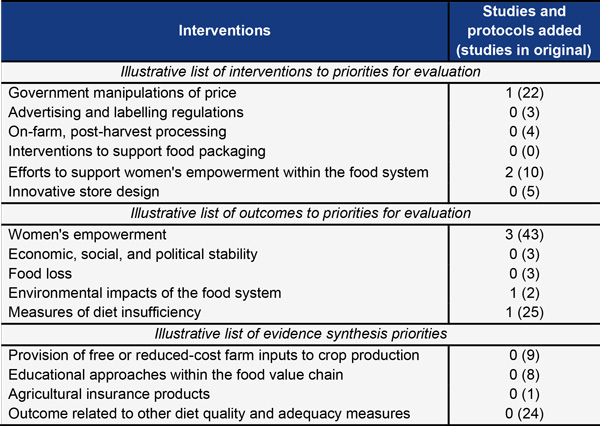Most new food systems research focuses on topics that previous research has already addressed, while only a handful of new studies break ground on under-studied priority subjects. This finding comes from newly-updated figures based on our first-ever living Evidence Gap Map on Food Systems and Nutrition, which we've written about previously on our blog here and here.
The original evidence gap map (EGM) was motivated by a pressing question: How do we achieve healthy diets for a growing global population without causing long-term harm to the planet? To do this, the international community has focused on transforming the food system — how food is grown, produced, distributed, sold, cooked, and consumed. Different interventions are being implemented and studied worldwide, resulting in a massive, but disorganized, evidence base. Due to the size and nature of this evidence base, it can be difficult for policymakers, researchers, and implementers to find the evidence they need. Our initial EGM, funded by the German Federal Ministry for Economic Cooperation and Development (BMZ) through the GIZ Knowledge for Nutrition (K4N) program, is the largest 3ie has ever produced.
Keeping up with the evidence
Given how quickly the field of food systems research is evolving, our EGM was likely to quickly become out of date. To respond to this issue, 3ie, again with support from GIZ, has converted its Food Systems and Nutrition Evidence Gap Map into a ‘living EGM’, which will be continuously updated through 2022. This ensures that the most recent research will be reflected in the map and readily available to stakeholders. It also allows us to easily identify changes in the evidence base. It will be particularly interesting to see if any of the identified evidence gaps are closed as a result of current and upcoming events and initiatives.
A living EGM is an entirely new product for 3ie. We continuously monitor literature to identify new studies and add them to the EGM. This process is facilitated in large part by the evidence surveillance 3ie is conducting for the Development Evidence Portal. Every three months, the changes to the EGM are compiled and summarized.
The living EGM – first additions
The searches for the original EGM were run in May 2020. The search for this first update was conducted in July 2021. We identified an additional 74 unique studies (73 impact evaluations and one systematic review) eligible for inclusion in the EGM. While drastic changes in the evidence base are not expected in a single year, a peek at the first summary of the living EGM allows us to explore what new food systems evidence is available.
- A focus on the food supply chain. Most of the new studies were concerned with the food supply chain (n=52), specifically the production system (n=42).
- Continued growth of well-represented areas of research. During the update, we added more studies on peer support and counseling (nine new studies added to 130 already included), classes on consumer behaviour (six new studies added to 245 already included), and fortification (five new studies added to 285 already included). These were all among the most-studied interventions in the original map.
- A move towards quasi-experimental designs. Eighty per cent of studies in the original EGM (January 2000-April 2020) used experimental designs, in comparison to 59 per cent in the update. Statistical matching (n=11) and difference-in-difference (n=9) are becoming more common.
- Filling gaps in the original EGM. New studies were published on governmental manipulations of price (n=1), women’s empowerment (n=1), and measures of diet insufficiency (n=1). We also found three protocols for studies that will fill previously identified gaps in women’s empowerment (n=2) and the environmental impacts of the food system (n=1). However, the research priorities identified in the original EGM should be maintained as these are not sufficient to fill existing gaps (Table 1).
Table 1: New studies in areas previously identified as priorities for research.
Further information on additions to the Food Systems and Nutrition EGM can be found here. If you are interested, have a look at the brief and the final report.











